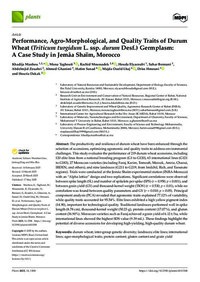Performance, Agro-Morphological, and Quality Traits of Durum Wheat (Triticum turgidum L. ssp. durum Desf.) Germplasm: A Case Study in Jemâa Shaïm, Morocco

Authors:
The productivity and resilience of durum wheat have been enhanced through the selection of accessions, optimizing agronomic and quality traits to address environmental challenges. This study evaluates the performance of 219 durum wheat accessions, including 120 elite lines from a national breeding program (G1 to G120), 63 international lines (G121 to G183), 27 Moroccan varieties (including Faraj, Karim, Tomouh, Marzak, Amria, Chaoui, IRDEN, and others), and nine landraces (G211 to G219, from Imilchil, Rich, and Taounate regions). Trials were conducted at the Jemâa Shaïm experimental station (INRA-Morocco) with an “Alpha lattice” design and two replications. Significant correlations were observed between spike length (SL) and number of spikelets per spike (SPS) (r = 0.950; p < 0.001), and between grain yield (GY) and thousand-kernel weight (TKW) (r = 0.530; p < 0.01), while no correlation was found between quality parameters and GY (r = 0.010; p > 0.05). Principal component analysis (PCA) revealed that agronomic traits explained 77.12% of variability, while quality traits accounted for 95.54%. Elite lines exhibited a high yellow pigment index (14.90), important for technological quality. Traditional landraces performed well in spike length (8.78 cm), thousand-kernel weight (50.23 g), protein content (17.07%), and gluten content (36.90%). Moroccan varieties such as Faraj achieved a grain yield of 6.12 t/ha, while international lines showed the highest SDS value (9.39 mL). These findings highlight the potential of diverse accessions for developing high-yielding, high-quality durum wheat.
